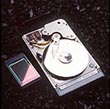
 |
|
If you're a professional photographer, the pattern at the right has changed or will soon CHANGE your life
|
This is a microscopic view of a CCD, each one of the purple coloured squares in the picture contains a pixel. Pixel is an acronym invented to describe the smallest picture element in CCD, it's comparable to a film grain on a roll of film |
What is "Digital Photography?
Most newspaper photographers these days still use film to capture their images, which is then scanned with a film scanner using CCD technology to "Digitize" an image into a computer file.
CCD's or Charged Coupled Devices where invented in the late 1960's by researchers at Bell Laboratories. They were conceived as a computer memory circuit and in 1970 were used to that end. But it was soon discovered that they had other applications like, signal processing and imaging. CCD's early promise as a memory element has since disappeared, but its use as a light sensor has boomed and found its way into many applications including Digital Photography.
If you have a house light which comes on automatically as it gets dark outside, you are already using CCD technology

This is Kodak's KAF-1300C Imaging sensor the heart of the most successful digital news cameras in use today, the Associated Press's NC 2000e and Canon's DCS-3 Digital Camera. This sensor is 20.5mm by 16.4mm in size and has 1.3 million pixels. The cost of this Imager is approximately $6000.00 for the CCD chip.
A CCD imaging capture is performed in three steps.
FIRST - is the exposure of the CCD to Light where the light is converted to an electrical charge
SECOND - the electrical charge is transferred from the pixel to the silicon substrate of the CCD
AND FINALLY - the charge is converted to voltage and amplified for output and storage.

This is an extreme microscopic view of a CCD showing 8 pixels. Silicon based CCD's are monochrome or Black and White by nature. In plain words they are colour blind, with no natural ability to see Red, Green and Blue light. There are different ways to overcome this but for our purposes the KAF-1300C CCD in our digital cameras uses a Integral Colour Filter Array to over come the colour blindness of the CCD.
In the manufacture of the CCD it is dyed Cyan, Magenta and Yellow in a pattern to produce a RGB image. In the picture you can see the result of this dying of the CCD to give it the ability to see colour.
 These hard drives have the
ability to store up to 340 megabytes currently or about 260 picture files
on one drive.
These hard drives have the
ability to store up to 340 megabytes currently or about 260 picture files
on one drive.
The hard drives are fragile and have been known to fail after a long period of use. While we had problems with the first Drives there are now many different manufactures on the market today producing much more robust products.
For those who are not convinced, visit Nick's Photo Gallery in these pages and judge for yourself. Chances are, you've been seeing digital news photographs in your newspapers and magazines now for two or three years and don't even know it. The mass consumer market for digital cameras has just exploded, and any self-respecting camera shop will feature several of these. There is now a high and low market for these, with an exchange of affordability and quality to match any budget.
The Photograph below was taken with the excellent Olympus D-300L, priced at around 900 US Dollars.

![]()